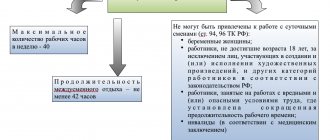When does a shift work schedule apply?
A shift schedule is a fairly common phenomenon. It is used in a wide variety of industries, most often in companies with a continuous round-the-clock production cycle - the need for its use here is due to the fact that equipment downtime is unacceptable, because they lead to system failures and significant financial losses. But regular, timely replacement of personnel leads to an increase in the volume of output, improved labor productivity and, as a result, greater profits.
Also, a shift schedule is common in other areas, for example, in medical institutions, security structures, firefighters, gas services, rail and transport transportation, air travel, etc.
Form and types of work schedule
The legislation does not provide for one standard form for the work schedule. It can be designed in the form of a table, diagram, etc. Often for this purpose, the 1C: Salary and Personnel program is used, which allows you to add the specifics of organizing the work of individual enterprises into ready-made forms. At the beginning of each such schedule, the following details are required:
- full name of the company and abbreviation (if available) or full name of the entrepreneur;
- document's name;
- when it comes into force and for what period of time it was developed;
- the name of the department (or other structural unit of the enterprise) for which it is intended.
When drawing up a work schedule, it is taken into account how many hours each employee works, what is the length of the working day at a given enterprise, what it does, and how the work process is organized. The work schedule may be:
- shiftable (recommended for production and service enterprises with a 24-hour work schedule;
- its main characteristic is the continuity of the work process);
- sliding (suitable for those companies where staff goes on business trips);
- weekly (employees are required to work a certain number of hours per week, and the time of their presence in the organization’s office is personally agreed with each person).
If employees work at the same time on certain days of the week, then drawing up a separate work schedule is not required; it is enough to stipulate this information in one of the clauses of the employment contract.
Why do you need a shift schedule?
The shift schedule is one of the most important internal documents of the company.
Based on the schedule, employees' working hours are recorded and their wages are subsequently calculated.
Thus, it relates not only to methods of organizing work at an enterprise, but is also a serious accounting form.
We must not forget that if the company provides for shift work, then the availability of the schedule is necessarily checked by government supervisory structures (for example, the labor inspectorate and the tax service). The absence of this document may result in the imposition of an administrative penalty on the enterprise and its management in the form of a fairly large fine.
Legislative regulation, mandatory conditions
The shift schedule is regulated by law, namely Art. 372 of the Labor Code of the Russian Federation (Part 3 of Article 103 of the Labor Code of the Russian Federation). When introducing it into an organization, it is required to strictly comply with the norms and conditions of the above section of the Labor Code of the Russian Federation.
The rules for operating in this mode are spelled out here quite thoroughly and clearly. There is no point in listing them in this article, but some simply need to be emphasized:
- the weekly working hours in the sum of all shifts should not exceed forty hours;
- every shift people should be given a lunch break (its duration is determined individually - from 30 minutes to 2 hours);
- employees must be provided with uninterrupted rest for 42 hours every week;
- the employer is obliged to indicate to employees that it is inadmissible for them to perform their duties in two shifts in a row (except in emergency cases) - and strictly monitor this.
If an organization feels the need to use a shift schedule for different categories (positions) of employees, then for each of them the duration of the shift can be determined separately (such situations occur in transport companies - one work mode is used for drivers, another for dispatchers, and another for service personnel). third).
When creating a schedule, one more important point should be taken into account - if most of it falls at night, then the shift should automatically be reduced by an hour.
All other working conditions must also comply with the law, including in matters relating to the payment of wages, provision of sick leave, vacation, etc.
In the labor regulations and in accordance with the Labor Code with employee shift schedules
A work schedule (or shift schedule) is just a calendar that determines on what day of the week and/or what shift (in time) an employee must go to work. The work schedule (shift) is drawn up on the basis of the work schedule, which is a mandatory condition of the employment contract. The regime is established either directly by the employment contract, if it differs from the general rules, or by the Internal Labor Regulations for this category of employees, which the employer is obliged to familiarize the employee with before signing the employment contract. Art. 57 of the Labor Code of the Russian Federation. Labor regime in accordance with Article 100 of the Labor Code of the Russian Federation Includes the type of work week, the number of shifts per day if the employee has a shift schedule, the duration of the working day (shift), the start and end time of work in a particular shift, the order of alternating working days (shifts) and days off, etc. In connection with the above, we can conclude that the requirement of the law (in this case, the requirement that the employee familiarize himself with the shift schedule in accordance with Article 103 of the Labor Code of the Russian Federation) to familiarize the employee is not related to the need to notify about the change terms of the employment contract, but for the purpose of preliminary informing the employee on what specific day of the week on what specific shift (the first, second or third, as defined by the shift) he must go to work in a specific month. The procedure for alternating working days and weekends or the duration of work in a particular shift cannot be changed unilaterally. It is for this purpose that the law defines such a period - no less than a month.
The employee gets acquainted with the schedule, which in this case is a local regulatory act and the employer does not have the right to change it unilaterally, either due to the illness of other employees or vacations. If an employee fails to show up for his shift as scheduled, the employer decides to replace the employee on that day either by attracting another employee to work on his day off (Articles 113, 153 of the Labor Code of the Russian Federation) or by temporarily transferring the employee while the absent employee performs the duties (Article 72.2 of the Labor Code of the Russian Federation), or hires an external employee under a fixed-term contract (Article 59 of the Labor Code of the Russian Federation). The employer does not have the right to change the schedule (change the number of shifts, the order of alternating shifts, the duration of work shifts), since this will change the work schedule of other employees, which is not permissible without compelling reasons and prior notification of employees at least two months before the introduction of changes (Article 74 Labor Code of the Russian Federation).
Based on the foregoing, we can conclude that the absence of an employee from work on his shift according to the approved schedule can be considered absenteeism, since the reason. The fact that the employer informed him one day later than the deadline established by law can hardly be considered valid. With all this, dismissal due to absenteeism is a right and not an obligation of the employer. Art. 192, 193 Labor Code of the Russian Federation.
What is not considered a shift schedule
Some personnel officers mistakenly believe that the work schedule is a day after two/three, two days after two, etc., refers to shift work. If you carefully read the labor legislation of the Russian Federation, it turns out that this is not so. A group of workers, performing their job duties during one day and being replaced by others the next day, works in a regime fixed within the enterprise, but there is no clear procedure for developing such a regime, its coordination and approval.
How is the document regulated by the Labor Code of the Russian Federation?
The shift schedule involves dividing employees (workers and other personnel) into equal groups. Each group, or shift, works a certain working time so that there are no violations of the articles of the Labor Code of the Russian Federation. This applies to:
- Article 91 of the Labor Code of the Russian Federation, according to which working hours should not exceed 40 hours per week ;
- Article 108 of the Labor Code of the Russian Federation, which indicates the need for a break for rest and nutrition (from 30 minutes to 2 hours);
- Article 110 of the Labor Code of the Russian Federation, which describes the time for weekly continuous leave (at least 42 hours).
The concept of “shift work” is regulated by Article 103 of the Labor Code of the Russian Federation. It is carried out according to the approved timesheet. In this case, it is not allowed for an employee to perform his job duties for two shifts in a row.
Detailed information about the preparation, approval and other nuances of the document is presented in the video:
Some points regarding payment
The calculation of remuneration for a shift schedule is somewhat different from the standard one. The specificity here is that the number of working hours according to the regime established at the enterprise may differ from the norm established by law, both upward and downward (the so-called planned overtime or underwork).
To ensure that there are no errors in salary calculations, at the end of the accounting period, the following parameters should be reconciled: the number of working hours in accordance with the norm and their number, based on real indicators. If, when comparing, the second indicator is greater than the first, you will need to calculate and pay the employee extra for overtime.
If an employee’s shift falls on a day off, then it is paid as usual (this is justified by the peculiarities of the shift conditions). If he is forced to work on a holiday (state non-working days are specified in the Labor Code of the Russian Federation), then he must be paid at the appropriate standard rate, i.e. in double size.
You cannot work two shifts in a row, even if the employee agrees
Shift work (two, three or four shifts) is introduced when the duration of the production process exceeds the permissible duration of daily work, as well as in order to more efficiently use equipment, increase the volume of products or services provided (Article 103 of the Labor Code of the Russian Federation).
The Labor Code (Part 5, Article 103) establishes a ban on working two shifts in a row.
In addition, it must be taken into account that working two shifts in a row entails infringement of the employee’s right to rest between shifts. By virtue of Part 1 of Art. 21, part 2 art. 22 and Art. 107 of the Labor Code of the Russian Federation, an employee must be provided with daily (between shifts) rest. Its duration is not regulated by the Labor Code of the Russian Federation.
Nevertheless, now, to the extent that does not contradict the Labor Code of the Russian Federation, paragraph 11 of the resolution of the Council of People's Commissars of the USSR dated September 24, 29 “On working time and rest time in enterprises and institutions switching to a continuous production week” continues to apply. According to this document, the duration of daily rest (between shifts, etc.) together with the lunch break must be no less than double the duration of work on the working day (shift) preceding the rest. This provision does not contradict the Labor Code.
Note that a similar rule is contained in the Sanitary and Epidemiological Rules SP 2.2.2.1327-03 “Hygienic requirements for the organization of technological processes, production equipment and working tools”, put into effect by Decree of the Chief State Sanitary Doctor of the Russian Federation dated May 26, 2003 No. 100.
Paragraph 10.24 of the above-mentioned Sanitary and Epidemiological Rules states that the duration of daily rest between shifts should be twice the duration of work. Less rest (but not less than eight hours) is permissible only in case of an emergency (emergency work).
Thus, the duration of rest between shifts for an eight-hour shift is at least 16 hours (including lunch break time).
An employee’s consent to work two shifts in a row has no legal significance. Provisions of agreements, collective and labor contracts or local regulations that do not comply with the requirements of the law are invalid (part 4 of article 8 and part 2 of article 9 of the Labor Code of the Russian Federation).
A way out of this situation, in our opinion, may be to involve the employee in overtime work in accordance with Art. 99 Labor Code of the Russian Federation.
The duration of such work in any case should not exceed four hours for the employee over two consecutive days and 120 hours per year. This norm cannot be canceled by agreement of the parties (Part 6 of Article 99 of the Labor Code of the Russian Federation). Therefore, an employee who has worked a shift, with his consent, can be brought to work in order to replace an employee who did not return to work only within four hours following the end of the shift or preceding its start. The other four hours can be worked by another employee.
An employer who is forced to hire workers outside the established working hours and is unable to comply with the restrictions established by Art. 99 of the Labor Code of the Russian Federation, has the right to hire workers on irregular working hours.
The specificity of this working time regime is that the employee in most cases is subject to the general work schedule, however, he may occasionally be late at work to perform labor functions beyond the established length of the working day (shift) or report to work before the start of the shift. In this case, overtime is compensated exclusively by additional leave (Article 119 of the Labor Code of the Russian Federation) and is not paid additionally. This is the main difference between overtime work and work with irregular working hours. In case of irregular working hours, overtime is not limited to four hours for two consecutive days and 120 hours per year. Similar explanations were given by Rostrud in letter dated 06/07/2008 No. 1316-6-1 “On working on irregular working hours.”
Please note: from Art. 99 of the Labor Code of the Russian Federation it follows that outside the established working hours within the framework of an irregular working day, an employee can perform only those labor functions that are provided for by his employment contract. In our opinion, it is unacceptable to use such a work regime in cases where before or after a shift an employee must perform functions that are not stipulated in his employment contract.
The duration of involvement in work outside of working hours during irregular working hours is not defined by law. It turns out that it is left at the discretion of the employer. But, in our opinion, a situation where an employee working irregular working hours is brought to work within eight hours after the end (before the start) of his shift can be regarded as an abuse of rights on the part of the employer. After all, such recruitment to work formally falls under the prohibition established by Part 5 of Art. 103 Labor Code of the Russian Federation.
Daily (between shifts) rest and days off (weekly continuous rest) are different types of rest time (Article 107 of the Labor Code of the Russian Federation).
The procedure for engaging in overtime work is somewhat different from the procedure for engaging in work on days off (Article 99 and Article 113 of the Labor Code of the Russian Federation). In addition, all work on weekends is paid at least double (Article 153 of the Labor Code of the Russian Federation). When working overtime, the first two hours are paid at least one and a half times the rate, and the subsequent hours at least double (Article 152 of the Labor Code of the Russian Federation).
Therefore, it is necessary to distinguish time worked overtime from time worked on days off.
In accordance with Part 3 of Art. 111 of the Labor Code of the Russian Federation, for employers whose work suspension on weekends is impossible due to production, technical and organizational conditions, days off are granted on different days of the week in turn to each group of employees based on the internal labor regulations. In other words, when working in shifts in an organization, weekly uninterrupted rest should be determined by the schedule in accordance with the internal labor regulations. It should be taken into account that weekly uninterrupted rest must be at least 42 hours (Article 110 of the Labor Code of the Russian Federation).
If an employee is involved in work in the period between the end of one of his shifts and the beginning of another (immediately after the end of the shift or after some time) and this period according to the schedule is considered a weekly continuous rest, then the work is paid in accordance with Art. 153 Labor Code of the Russian Federation. In other cases, overtime in excess of the normal number of working hours is paid according to the rules of Art. 152 Labor Code of the Russian Federation.
However, regardless of whether the employee works during a weekly continuous period or during inter-shift rest, the duration of such work, from our point of view, should not be eight hours following the shift that the employee must work according to the schedule, or preceding it.
Consolidating the work order
If the management of an enterprise decides to use a shift work schedule, it must enshrine this norm in its accounting policies, or more precisely, in its Internal Regulations.
If the company has a trade union cell, these Rules, including those regarding shift work, must be approved by its representative. A five-day period is allotted for interaction with the trade union - during this period, trade unionists must either approve the Rules presented to them or challenge them with evidence.
It is also possible to establish the use of a shift schedule in a collective agreement.
In addition to the internal regulations and the collective agreement, the clause on shift work must be spelled out in sections of individual employment contracts with employees, indicating the number of hours per shift and other parameters.
Duration of work
Working in shifts does not mean that an employee must perform his job functions for all 12 or 24 hours in a row. Do not confuse the concepts of total time spent at the workplace and the concept of direct work time.
The total time spent at work is the time that an employee spends from the moment he arrives at the workplace until the moment he goes home during the inter-shift rest period. This includes all hours, including those allocated for rest, meals, personal needs and other activities not related to his direct work.
Direct work time is the time when an employee performed the functions assigned by job or work instructions. Essentially, these are all useful actions of the employee, based on which the company should ultimately make a profit.
Typically, the actual duration of work of employees is determined based on the following criteria:
- Company operating technologies. This takes into account what equipment should work and how, or what services should be provided and at what time.
- Dedicated financial resource for wages. Based on it, you can calculate how many employees the company can hire to fulfill its obligations.
- Legislative restrictions. In this block, it is necessary to take into account the physiological characteristics of the human body, labor protection requirements, and industrial sanitation standards.
- Duration of working hours for a specific category of employees working in these working conditions.
- All periods of additional legal rest or absence from work. This point applies to employee vacations, as well as paid sick leave.
Remember, in order to correctly calculate the duration of work for each specific employee, it is necessary to take into account all production factors, as well as take average calculated data on legal absences to be able to predict the personnel reserve.
Taking into account all the above factors, shift schedules are drawn up. They are done separately for each division. Changes to this document are made in the same manner as it was compiled.
The process of creating a shift schedule
The first practical stage in implementing a shift schedule is an order for its creation, issued on behalf of the director of the organization. It contains instructions to create a shift schedule, period, responsible person and other necessary information.
Sample order for approval of shift schedule
Next comes the actual preparation of the document. The interests of the employer and employee must be taken into account here.
The schedule is formed in advance - at least thirty days before the start of the shift.
Each employee mentioned in the document must be familiarized with it against signature. Thus, he indicates that he agrees with this mode of operation.
After development, coordination and final approval, the schedule will be binding both for the management of the enterprise and for the employees designated in it.
Is it possible to change the information in it?
Changes are allowed to the approved shift schedule, but only as a last resort and in compliance with certain rules.
Firstly, if changes occur at the initiative of the employer, he must notify his subordinates in advance about them and obtain their written consent - without them, making changes legally will be problematic.
If one of the employees asks to change the shift schedule, he must draw up a special application addressed to the manager. The application must indicate the reasons for the request (it must be respectful with appropriate written justifications), then the consent of the other employees to whom the document concerns must be obtained. If colleagues and management managed to reach a compromise, a new order is formed, on the basis of which the necessary adjustments are made to the schedule.
How to coordinate with employees
The shift schedule must be agreed upon with employees in advance, as mentioned above - no later than thirty days before the start of the first shift.
Signatures of consent can be placed directly on the schedule itself, or you can make a separate sheet for this.
If the second option is chosen, then you need to make a table on the approval sheet, enter all the employees there and collect their autographs (with the date they were signed). This document will be an official attachment to the shift schedule.
Communication to employees
To officially communicate information to employees, it is necessary to understand the terms of their contracts. If the employment documents contain a clause about shift work, then, as required by Part 4 of Article 103 of the Labor Code of the Russian Federation, the employer should inform employees about the changes one month before their introduction. It is better to carry out this process in writing: otherwise it will be difficult to prove that specialists are aware of such radical innovations.
When it comes to a significant change in working conditions, such information is communicated to employees no later than 2 months before the planned events in the form of a written warning. The notification indicates the reasons for the transformations and their content.
Recommendation to HR employee. You can create an Appendix to the schedule, where each specialist puts his signature in the column “I am familiar with the shift schedule for the month ____.”
After familiarization, the document is mandatory for use by both the manager and the employee. Any deviation from the terms of the contract is considered a disciplinary offense. From this moment on, it is prohibited to change shifts and work overtime.
Features of the formation of a shift schedule, general information
If you are tasked with creating a shift schedule, and you have no idea how exactly it is formed, read our recommendations - they will give you an accurate idea of this document. Also check out the example of filling it out - based on it you can easily create your own form.
Before moving on to a detailed description of the schedule, we provide general information about the document. Let's start with the fact that there is no unified form of the schedule. This means that it can be written in free form or according to the model approved in the accounting policy of the organization. In this case, the method of forming the form must be reflected in the company’s regulations.
Regardless of which scheduling method is chosen, the document must contain a number of mandatory data:
- Company details;
- information about the place and time of compilation;
- the schedule itself.
The form must be certified by several persons. Firstly, by those employees in respect of whom it was formed, secondly, by the head of a structural unit and, thirdly, by the director of the company.
It is not necessary to certify the form with a seal - this should be done only when such a condition is in the company’s local documentation.
The schedule can be drawn up on a simple blank sheet of paper (preferably A4 format) or on the organization’s letterhead (if such a requirement is established by management). You can write it manually or on a computer (with mandatory subsequent printing).
Schedule
If an enterprise or organization introduces such a concept as a shift work schedule, the employer, in accordance with the law, is obliged to draw up a special, clearly thought-out schedule.
This schedule relates to local regulations; it must indicate:
the maximum possible number of shifts;- duration of one shift;
- shift order;
- weekends and rest hours between shifts and working days;
- breaks during the shift for meals and rest.
In addition, the schedule must stipulate what actions employees and employers take in the event of a shift worker’s no-show, what rights and responsibilities an employee has if he expresses a desire to switch to a different work schedule or completely abandon the shift schedule, etc.
If an employee has entered into an employment contract for a specific work schedule, and during this period there is a transition to shift work, he has the right to work for two months in the previous mode, and then switch to shift work. Or terminate the employment contract if it is not possible to offer him another vacancy - on the basis of Article 77 of the Labor Code of the Russian Federation.
With a two-shift work schedule, the shifts are divided into:
- daytime;
- evening or night.
A shift is considered a night shift if more than half of the time is spent at night. The shift before it is called evening .
The two shifts last a total of 16 hours. But if an organization operates on a 24-hour basis, the day is often divided into two 12-hour shifts.
In this case, the day shift begins at 8 am and ends at 8 pm. Accordingly, the night shift begins at 8 pm and ends at 8 am.
According to the established rules, employees are not authorized to independently change their schedule, without approval from the administration, that is, they cannot voluntarily go to work on a shift other than their own.
With a three-shift work schedule, the day can be divided into three periods, each of 8 hours. Employees are divided into four or five teams, depending on the number of personnel and production requirements.
If four teams are involved, then usually three of them work, changing every 8 hours a day, and one rests. A schedule is drawn up similarly for five teams, with three or four at work and one or two at rest.
The teams must alternate evenly, that is, one team per week cannot work only on the night shift or only on the day shift.
Typically, a worker first goes on the first shift, then the second and third, after which the cycle repeats. But a schedule can also be drawn up in which an employee works two day shifts in a row, then two evening or night shifts.
According to Article 103 of the Labor Code of the Russian Federation, the employer is obliged to notify its employees no later than a month before switching to a shift work schedule.
How to take into account the shift schedule
All schedules developed at the enterprise are subject to mandatory registration in the appropriate accounting journal. After carrying out all the necessary procedures with them (development, coordination, approval, familiarization), they are transferred for storage to the company’s HR department. Here they are filed in a separate folder with other similar documents. Access to the place of their detention for unauthorized people should be limited.
The duration of their storage is indicated either in local acts of the organization, or is established by the legislation of the Russian Federation (but not less than five years). After this period has expired, the schedules can be disposed of in accordance with the procedure established by law.








